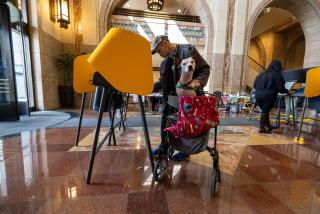Elections to Decide Key Issues in Cities
- Share via
They may lack the sizzle of a presidential contest, but Tuesday’s “off year” local elections nonetheless will have a big impact on schools, beaches, hillside development and even airports.
In the fast-growing suburbs of north Los Angeles County, voters will consider several measures to expand school districts that are bulging at the seams. Several valleys away in the slow-growth hamlet of Agoura Hills, meanwhile, a plan to open a Home Depot superstore has electrified the City Council race.
Among the most closely watched elections is one in Carson, where voters decide whether schools in their city will be the first to split from the massive Los Angeles Unified School District in more than 50 years. In Hawthorne, voters will weigh in on whether the city should close its historic but underutilized municipal airport and develop the site in hopes of bringing in more tax dollars.
These issues lead a list of more than two dozen local ballot measures facing voters around the region on Tuesday. Most, including a handful of school and community college bond measures, focus on taxes or “quality-of-life” issues, such as a call to restrict seaside events in Hermosa Beach and ban fireworks in Baldwin Park.
Also on many local ballots are contests to fill seats on city councils, school and college boards and on lesser-known water, library, community service and irrigation districts.
In the Santa Clarita Valley, the William S. Hart School District seeks a $158-million bond to build 10 schools, and the two-year College of the Canyons has asked voters to approve $82.1 million for new classrooms. Each institution has about 7,000 more students than schools were designed to teach.
The Palmdale School District in the nearby Antelope Valley hopes to pass a $25-million bond to build two schools. Officials say they lack permanent class space for 8,700 kids in a city whose population has soared 70% during the last decade.
“It would take two years to build those schools,” said district spokesman Isaac Barcelona. “And by then we will have grown another two schools. We’d still be in the hole, in other words.”
Palmdale voters will also weigh a controversial measure to assign each of four at-large council members to specific geographic districts. The lawmakers would still be chosen in citywide elections, as would the mayor.
The measure’s sponsor, Mayor James Ledford, the only council member who lives on Palmdale’s more working-class east side, said it would help spread representation. But opponents contend it is a thinly disguised bid by the mayor to increase his power and punish his foes.
Political tempers are also running high in Agoura Hills, where eight candidates are vying for three City Council seats. A potential Home Depot store has emerged as the key issue in perhaps the nastiest race in the city’s two-decade history.
Developer Dan Selleck is expected to propose a 115,000-square-foot store as part of an ambitious retail complex on Agoura Road. Three incumbents have pledged to withhold judgment until a formal plan is presented. Other contenders have spoken out against the idea.
“Home Depot is not a good fit for Agoura Hills,” said candidate Ken Horton, 54, a local businessman who said he fears that the hardware megastore would destroy the city’s “open spaces, . . . our small-town feel.”
Election day has not stoked nearly so much passion in nearby Westlake Village, where voters will choose three council members.
“That’s the problem with the election,” said Mayor Mark Rutherford, one of two incumbents seeking another term. “There’s not a lot of controversy. By and large, everybody is very happy with the way Westlake Village works.”
Two initiatives are also on the Westlake Village ballot. Measure T would ratify a hotel tax hike from 6% to 10%, while Measure U would give the city the option of raising it to 14%.
Residents will also choose three board members for the Las Virgenes Unified School District from a field of five. The biggest challenge facing the district, most agree, is reducing the number of students in two crowded middle schools.
In Carson, Measure D asks voters whether to carve out a 21,500-student, kindergarten-through-12th-grade system from the Los Angeles Unified School District and, to a smaller extent, the Compton Unified School District. At the same time, voters will be asked to choose among 18 candidates for a five-member board for the new district.
Would-be municipal secessionists in Los Angeles from the San Fernando Valley and the Harbor area are watching Carson, where the measure’s supporters are promising that an independent school district would improve student achievement, be more responsive to parents and spend tax dollars more wisely than the nation’s second-largest school district.
Leaders of the drive to form a Carson Unified School District, however, have raised less than $5,000 and are relying on lawn signs, precinct walks, a series of public forums and mailers to get their message to voters.
The “Carson for Kids: No on Measure D” side is financed almost entirely by the powerful United Teachers-Los Angeles, which has pumped more than $125,000 into the campaign.
Opponents say the new district would lose most of its teachers. They also cite Los Angeles’ popular magnet programs and recent improvements in test scores as reasons not to secede.
There is also wide interest in Hawthorne’s advisory measure concerning the future of the municipal airport.
Paladin Partners, a Los Angeles development firm, wants to replace the 80-acre airport alongside the Century Freeway with an open-air complex of shops and restaurants, a hotel and movie theaters. Proponents say the complex would boost tax revenues by almost $4 million annually in a city still struggling to recover from aerospace and defense industry cutbacks a decade ago.
But airport supporters--including area pilots and state and national aviation associations--contend the city would be giving up a valuable asset for uncertain gains.
A big issue has been what would happen if the Hawthorne airport were to close and its airspace, now reserved for small, relatively quiet planes, were ceded to nearby LAX.
Airport supporters say an LAX takeover of the airspace would send jumbo jets swooping in low over Hawthorne homes, but the FAA has said such flight patterns are not feasible.
Other measures attempt to address “quality of life” issues.
In Baldwin Park, the election is guaranteed to be full of fireworks--literally. Measure S would ban fireworks sales and possession in the community, where 14 clubs and charitable associations raised about $300,000 through such sales last year.
Citing safety concerns, Councilwoman Linda Gair persuaded her colleagues to put the measure on the ballot. Opponents have raised more than $40,000 to fight it.
In Ventura, where politics are dominated by ways to maintain growth restrictions while attracting jobs and affordable housing, voters will decide whether to have a direct say in development on the coastal city’s hillsides and canyons.
A group of landowners is seeking to build as many as 1,900 homes on 6,100 acres just north of the city. Measure P would require voter approval before city water and sewer services could be extended to the proposed development sites.
In Hermosa Beach, a “coastal conservation act” sponsored by a local activist has created a stir because it would restrict large events within the city’s coastal zone. Activist Donley Falkenstien, who led a successful 1997 fight to bar the Assn. of Volleyball Professionals from charging admission to tournaments in neighboring Manhattan Beach, said he wants to keep coastal neighborhoods from being overrun by commercial events.
But opponents, led by Mayor John Bowler, said the measure is overly broad and would cede control of the city’s beaches to the state and put a damper on such beloved community events as pancake breakfasts and Easter egg hunts.
Several school and community college districts are seeking voter approval to sell bonds to build or upgrade campuses. They may benefit from last year’s Proposition 39, by which California voters lowered the bar for school bond elections, dropping the required yes vote from 66% to 55%.
In addition to the campaigns in Santa Clarita and Palmdale, the Mount San Antonio Community College District in eastern Los Angeles County is seeking $221 million in bonds to remove asbestos, add new science labs, and modernize and build more classrooms. And in El Segundo, south of LAX, voters are asked to approve $25 million in bonds to refurbish the town’s beautiful but antiquated high school.
Three area cities are pushing for other types of bond measures, which require two-thirds approval. Malibu wants $15 million to buy land for recreational uses and for a wildlife habitat. Otherwise, backers say, the sites will be gobbled up by builders. A typical Malibu property would pay an estimated $127 a year in additional taxes.
City officials in the San Gabriel Valley community of Azusa want a $5.875-million bond measure for a new library building in its civic center. The measure, which would add about $24 a year to a typical home’s tax bill, enjoys broad support.
And in well-heeled Manhattan Beach, officials are hoping voters will approve $15 million in bonds to help replace cramped and aging police and fire headquarters.
Several cities are looking for ways to raise taxes--or at least maintain them at current levels. In the South Bay city of Rancho Palos Verdes, officials want permission to keep the hotel tax, along with a twin measure for the city’s golf fees tax, both at 10%. Neither measure would have a major effect on the city treasury, however, unless a controversial hotel and golf resort proposed for the site of the long-closed Marineland sea life park is built.
Hotel taxes also are on the ballot in Hawthorne. Measure B asks voters to increase the hotel tax from 8% to 12%.
Voters in Monterey Park in the San Gabriel Valley will consider a 25-year special parcel tax to pay for six new paramedics and the reconstruction of two fire stations. The measure needs approval from two-thirds of voters to pass.
But in Torrance and Hermosa Beach, local anti-tax activists are spearheading campaigns--opposed by most leaders in both cities--to roll back levies, not add to them.
Measure Q would repeal lighting district assessments in Torrance.
Measure H in Hermosa Beach would discontinue the city’s utility users tax, the third-largest revenue source for the small coastal community. Without the tax, which amounts to about $10 a month for most residents, Hermosa Beach would have to lay off employees, including police officers and firefighters, Measure H opponents say. But proponents argue it would force the city to run a tighter fiscal ship.
Governance issues await some voters. Hermosa Beach and Palmdale voters will decide whether to impose term limits on council members.
Compton voters will participate in the first Compton Unified School District School Board election in which members will have control over the district since it was taken over by the state more than eight years ago. Twenty-eight candidates are vying for five seats.
In Orange County, 10 candidates are vying for four trustee seats in the Orange Unified School District, which made national headlines in 1999 when it tried to block a gay student club. The club, which was later allowed on campus as long as sex was not discussed, was only one chapter in the troubled school system’s history.
Tuesday’s election there is dominated by the long-boiling clash between the teachers union and the school board, which led to a successful recall election last June and a shift in the balance of power; now two of the ousted trustees are seeking to reclaim their seats.
*
Times staff writers Patricia Ward Biederman, Richard Fausset, Sue Fox, Erika Hayasaki, Laura Loh, Zanto Peabody, Bob Pool, Margaret Talev, Richard Winton and Daniel Yi contributed to this story.
More to Read
Sign up for Essential California
The most important California stories and recommendations in your inbox every morning.
You may occasionally receive promotional content from the Los Angeles Times.











